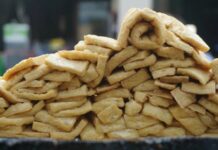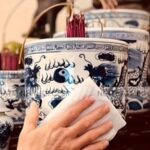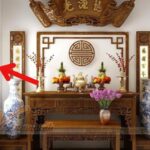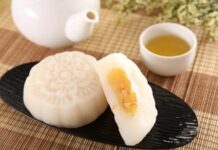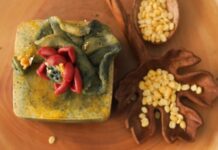“Every year, peach blossoms bloom
Again, the old calligrapher appears
Displaying ink, red paper
On the bustling street where people pass by”
For generations, our ancestors have believed that each character represents knowledge, paving the way for a brighter future. At the beginning of spring, when the essence of heaven and earth converges and flourishes, seeking calligraphy brings prosperity to one’s career and family.
In other words, the tradition of seeking calligraphy at the start of the Lunar New Year is a cherished Vietnamese custom, reflecting a deep respect for learning and a desire for good fortune, happiness, and peace in the coming year. People often seek calligraphy from those with virtue, talent, and beautiful handwriting, such as scholars, teachers, and calligraphers.
Each calligraphic character carries its own meaning, suited to the profession, work, and wishes of the person seeking it. For example, students often seek the characters for “Talent” or “Wisdom,” while those already working may seek “Achievement” or “Patience.”
The Meaning of Seeking Calligraphy at the Start of the Year

How to Properly Seek Calligraphy During Tet?
Since ancient times, seeking calligraphy at the start of the year has symbolized respect for knowledge and the moral values of our ancestors. Those seeking calligraphy typically prepare small offerings like betel leaves, areca nuts, or medicinal tea, and then visit respected calligraphers in their area.
This choice is not just about obtaining beautiful calligraphy but also about conveying heartfelt wishes and aspirations for the new year.
Today, seeking calligraphy has become more accessible and widespread, thanks to the emergence of calligraphy streets, where people can choose calligraphers whose style and blessings align with their preferences.
Calligraphers are not only skilled in their craft but also embody a love for learning and a noble spirit. For those who appreciate traditional calligraphy, experienced masters are an ideal choice.
For those who prefer modern and creative styles, young calligraphers offer a refreshing alternative. Each person can select a character that aligns with their personal wishes and aspirations for the new year.

Which Characters Are Commonly Sought During Tet?
– Phúc (福): One of the most beloved characters, symbolizing happiness, prosperity, and good fortune. It conveys a message of a fulfilling life, family harmony, good health, and all-around blessings.
– Lộc (禄): Represents wealth, career success, and prosperity. Seeking this character at the start of the year expresses a desire for sustainable professional growth and financial stability.
– Thọ (寿): A character for those wishing for good health and longevity. It’s not only a personal wish but also a blessing for parents and elders.
– An (安): Symbolizes peace and tranquility, free from life’s storms. It’s ideal for those seeking a stable year with family harmony and smooth work.
– Tài (财): Represents talent and remarkable career success. This character is for those with strong ambitions in their profession and finances.
– Hiếu (孝): Embodies gratitude toward parents and ancestors. Seeking this character is a way to express respect, filial piety, and appreciation for their upbringing.
– Tâm (心): Conveys a message of inner peace, helping one remain calm amidst life’s challenges. It’s for those seeking a simple, serene year, free from turmoil.
– Nhẫn (忍): Represents patience, perseverance, and tolerance. In 2025, this character serves as a reminder to stay resilient and overcome challenges with patience and virtue.
– Đức (德): Encourages living with morality and kindness. It’s suitable for those aspiring to a harmonious life, guided by a clear conscience and fairness.

Important Notes When Seeking Calligraphy at the Start of the Year
To ensure the tradition of seeking calligraphy is meaningful and upholds its cultural value, consider the following:
– Choose a reputable calligrapher: Selecting a skilled and respected calligrapher ensures you receive a beautiful, artistically crafted piece. A calligrapher not only writes but also imparts blessings through their work.
– Decide on the character you wish to seek: Beforehand, reflect on the character that best aligns with your aspirations. If unsure, consult the calligrapher for guidance.
– Avoid seeking too many characters: Requesting too many diminishes the sacredness of each character. Choose one or two that hold deep personal significance.
– Prepare paper and preservation tools: Bring paper and protective materials like folders or sleeves to safeguard the calligraphy from damage.
– Maintain a respectful attitude: Approach the calligrapher with reverence and maintain a solemn demeanor. A respectful atmosphere enhances the positive energy for the new year.
Expert in web design and development with over 15 years of experience. I’ve helped hundreds of businesses develop comprehensive website strategies for sustainable growth and profitability.
Plant These 5 Trees in Front of Your House: Attract Wealth and Prosperity for All 5 Chinese Elements
Are you aware that planting the right tree in front of your house can attract wealth and prosperity for your entire family? Whether you’re a believer in the elements of Metal, Wood, Water, Fire, or Earth, the following ornamental plants and trees are a perfect fit and bring good fortune. Let’s discover which plants these are!
The Ancient’s Advice: Why Abstain from Burning Incense on the Night of the 1st and 15th? Optimal Timing for Incense Offering.
Incense burning is an integral part of Vietnamese spiritual rituals, especially on the first and fifteenth day of the lunar month, as well as during festivals and holidays. However, there is a longstanding tradition of refraining from burning incense in the evening, and specific timings are recommended for this practice.











